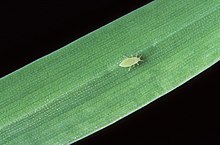Russian wheat aphid: Difference between revisions
clean up, removed orphan tag using AWB |
→External links: Updated link to Kansas State University publication. |
||
| Line 18: | Line 18: | ||
==External links== |
==External links== |
||
* [http://www.invasivespeciesinfo.gov/animals/rwa.shtml Species Profile- Russian Wheat Aphid (''Diuraphis noxia'')], National Invasive Species Information Center, [[United States National Agricultural Library]]. Lists general information and resources for Russian Wheat Aphid. |
* [http://www.invasivespeciesinfo.gov/animals/rwa.shtml Species Profile- Russian Wheat Aphid (''Diuraphis noxia'')], National Invasive Species Information Center, [[United States National Agricultural Library]]. Lists general information and resources for Russian Wheat Aphid. |
||
*[http://www. |
*[http://www.ksre.ksu.edu/library/entml2/mf2666.pdf Russian Wheat Aphid] |
||
[[Category:Aphids]] |
[[Category:Aphids]] |
||
Revision as of 15:41, 16 February 2012
| Russian wheat aphid | |
|---|---|

| |
| Scientific classification | |
| Kingdom: | |
| Phylum: | |
| Class: | |
| Order: | |
| Suborder: | |
| Superfamily: | |
| Family: | |
| Genus: | |
| Species: | D. noxia
|
| Binomial name | |
| Diuraphis noxia Kurdjumov, 1913
| |
The Russian wheat aphid (Diuraphis noxia) is an aphid that can cause significant losses in cereal crops. The species was introduced to the United States in 1986 and is considered an invasive species there. This aphid is pale green and up to 2 mm long. Cornicles are very short, rounded, and appear to be lacking. There is an appendage above the cauda giving the aphid the appearance of having two tails. The saliva of this aphid is toxic to the plant and causes whitish striping on cereal leaves. Feeding by this aphid will also cause the flag leaf to turn white and curl around the head causing incomplete head emergence. Host plants: cereal grain crops including wheat and barley and to a lesser extent, wild grasses such as wheatgrasses, brome-grasses or ryegrasses.
External links
- Species Profile- Russian Wheat Aphid (Diuraphis noxia), National Invasive Species Information Center, United States National Agricultural Library. Lists general information and resources for Russian Wheat Aphid.
- Russian Wheat Aphid
